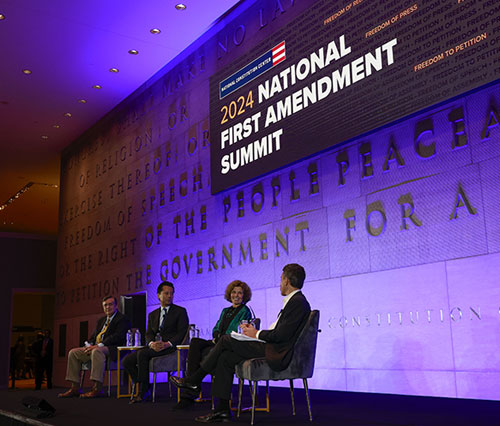Essays Library

Starting with an overview essay from National Constitution Center president and CEO Jeffrey Rosen, leading scholars take a fresh look at the Declaration of Independence—its text, its history, its key principles, its signers, and its influence across American history and around the world.
“One People”: An Introduction to The Declaration and the Constitution

By Jeffrey Rosen
President & CEO of the National Constitution Center
Jeffrey Rosen explains how a debate between Hamilton and Jefferson has framed the epic battles about how to balance liberty and power that have unfolded throughout American history.
7:28
Jefferson, Adams, and the Crucible of Revolution

By Jane Kamensky
President, Monticello
Jane Kamensky explores how for all their differences, John Adams and Thomas Jefferson became figures in an important chapter in the “American story.”
4:20
The Declaration, the Constitution, and the Idea of Equality

By Danielle Allen
Bryant Conant University Professor at Harvard University
Danielle Allen discusses the evolution of the principle of equality in the Declaration and its evolution over time through the Constitution and the law.
The Declaration of Independence and The Concept of Liberty

By Robert P. George
McCormick Professor of Jurisprudence, Director, James Madison Program, Princeton University
Robert P. George writes that the preservation and protection of liberty is at the core of our nation’s promise, but how we understand the normative content of liberty matters greatly.
The Pursuit of Happiness

By Jeffrey Rosen
President & CEO of the National Constitution Center
Jeffrey Rosen notes that the Founders viewed the pursuit of happiness as a lifelong quest for character improvement, and their belief that happiness is always something to be pursued rather than obtained.
6:58
The Consent of the Governed

By Gordon S. Wood
Alva O. Way University Professor and Professor of History Emeritus, Brown University
Gordon S. Wood reviews why the Declaration of Independence’s assertion that governments derive their just powers from “the consent of the governed” was one of the most important issues in the revolutionary era.
6:08
The Declaration’s Grievances Against the King

By Rosemarie Zagarri
Distinguished University Professor, George Mason University
Rosemarie Zagarri explains that while the list of grievances is today an overlooked part of the Declaration of Independence, the list was arguably the most critical section of the document in 1776.
7:01
Concluding Independence

By Lindsay M. Chervinsky
Executive Director, George Washington Presidential Library
Lindsay M. Chervinsky shows how the conclusion at the end of the Declaration dissolved political connections to the Crown and established a new government for a sovereign nation.
6:34
The Declaration of Independence’s Influence Around the World

By David Armitage
Lloyd C. Blankfein Professor of History, Harvard University
David Armitage explores the Declaration of Independence’s impact in world history as well as its significance within the United States, though for distinct and different reasons.
6:01
The Separation of Powers

By Yuval Levin
Beth and Ravenel Curry Chair in Public Policy, Director of Social, Cultural, and Constitutional Studies, American Enterprise Institute
Dr. Yuval Levin of the American Enterprise Institute argues that the defense of liberty requires multiple answers to a fundamental political question: who rules?
6:28
Federalism

By Hon. Jeffrey S. Sutton
Chief Judge, United States Court of Appeals, Sixth Circuit
Judge Jeffrey S. Sutton explains that federalism is a singular question in American history with a debate that never goes away.
5:52
The Blessings of Liberty and Bills of Rights

By Mary Sarah Bilder
Founders Professor, Boston College Law School
Mary Sarah Bilder reviews how over two centuries, the Bill of Rights developed as a culture of rights and liberties as bulwarks against power.
7:56
The Declaration’s Promises

By Eric Slauter
Deputy Dean of Arts and Humanities and the College, University of Chicago.
Eric Slauter notes that the Declaration’s stirring words are a testament to the power of ideas and to the efforts of ordinary Americans to press them into service for change.
More on the Declaration
Learn more about the delegates who signed the Declaration, its impact across history, and exciting new content and events related to its 250th anniversary.

The Declaration Across History
Read excerpts from historic documents, curated by scholars, that draw on the push for a range of visions for America.

Signers of the Declaration
Historian Carol Berkin shares definitive short biographies of the 56 men who signed the Declaration. This section also includes an engaging video for each signer.

America at 250 Civic Toolkit
The toolkit brings to life the Declaration, the Constitution, and enduring principles that define America. It features America at 250 multimedia content, events, and continuously updated resources.




